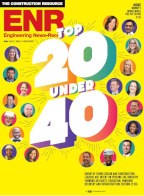Construction Spending Edges Higher During May
Total construction spending edged higher for the third straight month in May, as solid increases in private nonresidential and public construction outweighed a downturn in residential projects, according to new Census Bureau data.
Nonresidential construction spending rose 1.1% on a monthly basis in May and has increased 6.4% on a year-over-year basis. Spending for the month totaled $596.2 billion on a seasonally adjusted, annualized basis. Additionally, nonresidential construction spending for April was revised upward from $570.6 billion to $589.9 billion.
“The May figures show that construction activity continues to expand, but with lots of variability by month and project type,” said Ken Simonson, chief economist for AGC of America. “These uneven patterns seem likely to continue for the rest of the year.”
Construction put in place was 6.6% higher than in May 2013. For the first five months of 2014, total spending rose 8.2% from the January-May 2013 total.
“Nonresidential construction spending is now at its highest level since October 2009, though that does not account for the cost of inflation,” said ABC Chief Economist Anirban Basu. “The latest numbers help confirm ABC’s notion that the winter decline in nonresidential construction spending was largely due to unusually harsh weather as opposed to shifting economic fundamentals.”
Private residential construction spending in May retreated 1.5% from April, when homebuilders may have put in extra hours to make up for adverse winter weather in many regions. The May total was 7.5% above the May 2013 level, representing an 11% increase in single-family spending, 31% for multifamily and a 2.4% decline in improvements to existing housing.
Private nonresidential spending rose 1.1% in May and 11% over 12 months. The largest private segment, power construction—comprising work on oil and gas fields and pipelines as well as electricity projects—rebounded 4.3% from a sharp drop in April and was up 30% year-over-year. Among other major private nonresidential segments, commercial construction—retail, warehouse and farm projects—climbed 6.5% over 12 months; manufacturing construction rose 6.7%; and office work jumped 23%.
Public construction spending rose 1.0% for the month and 1.2% year-over-year. The largest public segment, highway and street construction, expanded 2.3% from a year before. The second-biggest category, educational construction, gained 1.7% since May 2013.
“The outlook is brightest for multifamily and oil and gas-related projects, including manufacturing.” Simonson said. “But single-family and office construction, which have done well so far, may fade later this year.”
“ABC’s economic forecast continues to call for ongoing healing in the industry,” said Basu. “Given recent hiccups in U.S. macroeconomic performance, as measured by gross domestic product, and public funding constraints, gradual recovery is perhaps the best the overall industry can anticipate.”
Eleven of 16 nonresidential construction subsectors posted increases in spending in May.
• Office-related construction spending grew 0.6% in May and is up 18.9% from the same time a year ago.
• Construction spending in the transportation category expanded 2.2% on a monthly basis and has risen 7.5% on a year-over-year basis.
• Religious spending grew 1.4% for the month, but is down 3.9% from the same time last year.
• Sewage and waste disposal-related construction spending gained 4% for the month, but has fallen 1.3% on an annual basis.
• Amusement and recreation-related construction spending expanded 3.1% on a monthly basis and is up 8.5% from the same time last year.

